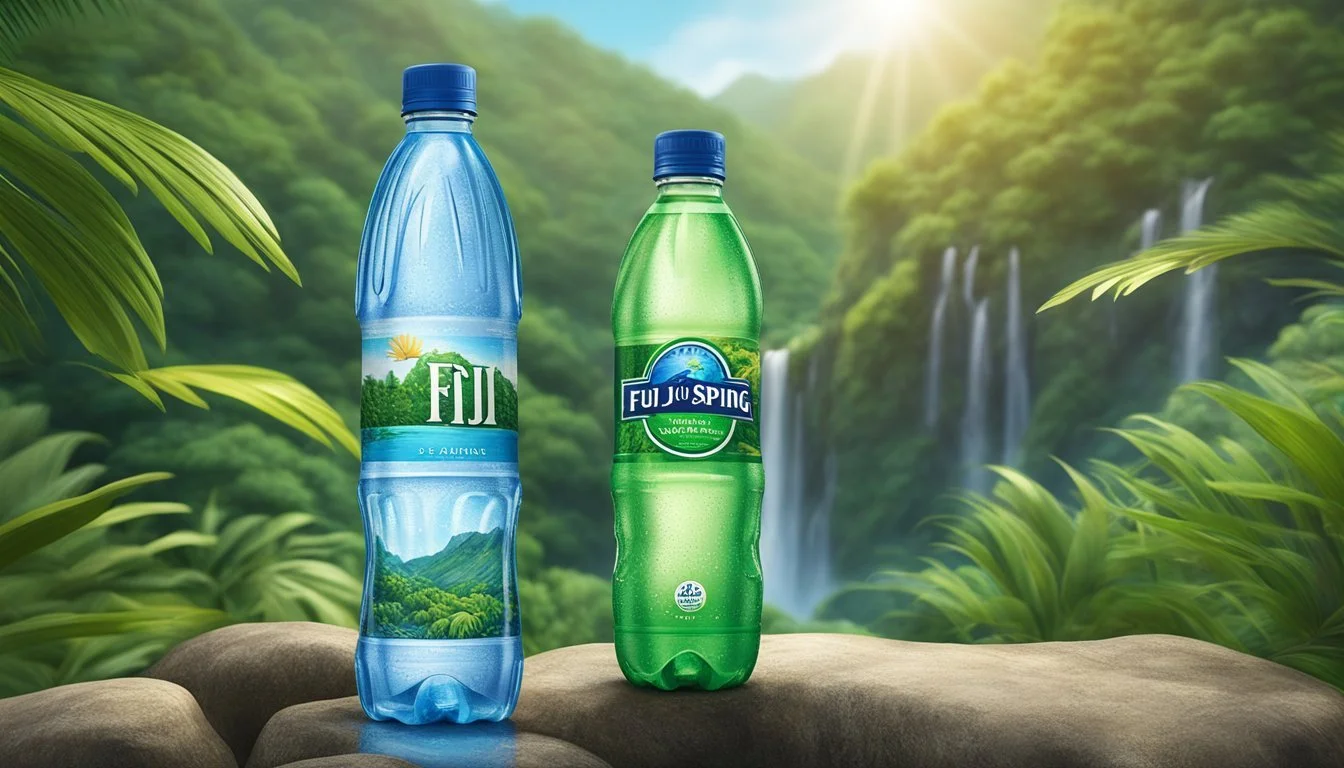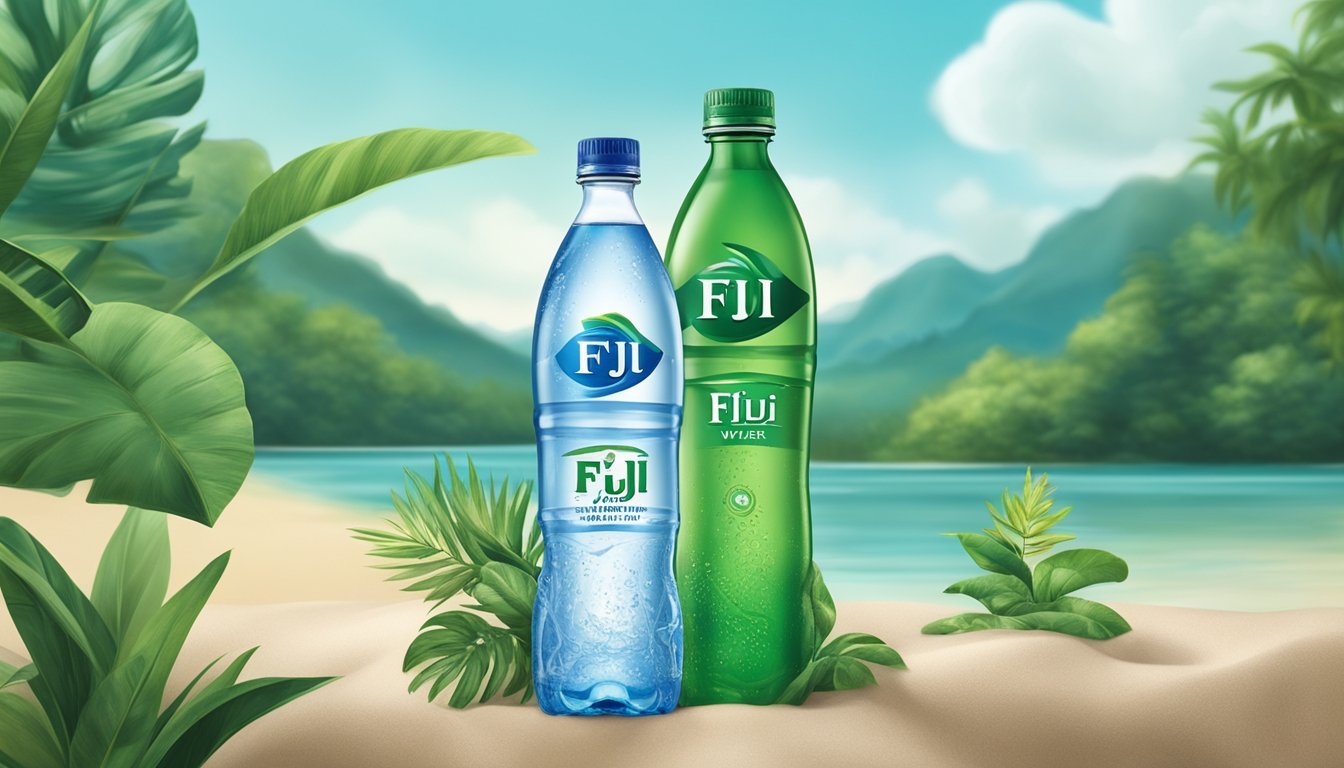Fiji vs. Poland Spring
Comparing Quality and Taste in Bottled Water Brands
In the realm of bottled water, consumers are faced with a plethora of choices, each brand touting its own unique benefits. Fiji and Poland Spring represent two prominent brands that have garnered distinct followings. Fiji Water, sourced from an underground aquifer in the Fiji Islands, is known for its soft mouthfeel and unique mineral profile, which is the result of the volcanic rock it filters through. The brand presents itself as a premium option, offering water that's untouched by human hands until you unscrew the cap.
On the other side, we have Poland Spring, a brand steeped in history, with its source dating back to 1845 in Maine. Poland Spring markets its product as 100% natural spring water, emphasizing its local origins and regional accessibility. It once faced scrutiny and legal challenges regarding the authenticity of its spring water claims, which the company has addressed. Such controversies highlight the importance of transparency and consumer trust in the bottled water market.
When comparing Fiji with Poland Spring, the debate often transcends mere taste preference, delving into environmental impact, corporate responsibility, and the authenticity of source claims. This comparison aims to provide consumers with a clear and unbiased understanding of the qualities and reputations that each brand upholds in an industry where the product is seemingly ubiquitous yet the differences can be deep and meaningful.
Historical Background
Fiji Water traces its origins to the Fiji Islands, specifically the main island of Viti Levu. It is sourced from an underground aquifer in the Yaqara Valley of Viti Levu, where the water is naturally filtered and protected from external elements. The brand itself was founded in 1996, capitalizing on the purity of its source and marketing itself as a luxury product.
Poland Spring boasts a history dating back to the 19th century. Originating from Maine, this brand's name is derived from the original spring in the town of Poland Spring, discovered in 1797. The water from this spring was believed to have healing properties, and by the early 20th century, Poland Spring was selling water coast-to-coast.
Brand History Origin Source Founded Notable Facts Fiji Water Yaqara Valley, Viti Levu, Fiji 1996 Markets as a luxury product, sourced from an artesian aquifer Poland Spring Poland Spring, Maine, USA 1845 One of America's oldest bottled water brands, believed to have medicinal qualities from the start
Both companies harness the marketing appeal of their unique sources. Fiji Water emphasizes its exotic and untouched source, while Poland Spring highlights its historical American roots. Both have expanded considerably since their inception, catering to a global market with a variety of bottle sizes and types. Each has cultivated a reputation for quality, with Poland Spring focusing on its regional heritage and Fiji Water on its international luxury status.
Source and Natural Composition
The quality and taste of bottled water are deeply influenced by the sources they originate from and their natural composition. Fiji Water and Poland Spring Water, two popular brands in the bottled water market, pride themselves on the unique sources and mineral content of their products.
Fiji Water Source
Fiji Water claims its source is an underground aquifer in the remote Yaqara Valley of Viti Levu, the largest island in Fiji. The water is naturally filtered through volcanic rock which infuses it with minerals and electrolytes. This process lends Fiji Water its signature soft mouthfeel and a high silica content that is believed to offer health benefits.
Poland Spring Water Source
Poland Spring sources their water from multiple springs in Maine, including a famous site in Poland Spring and other carefully selected natural springs. Allegedly dating back to a mountain spring found by Hiram Ricker in the 1800s, Poland Spring maintains that their water is naturally filtered and contains the right balance of minerals, contributing to its refreshing taste and quality.
Water Quality and Content
When comparing Fiji and Poland Spring bottled waters, it's essential to examine specific aspects of their water quality, including mineral content, pH balance, presence of electrolytes, and purity standards.
Mineral Content and Health Benefits
Fiji Water is known for its high levels of silica, which some studies suggest can support bone health, and also contains calcium, magnesium, and bicarbonate. These minerals provide a smooth taste and can be beneficial for health due to their roles in bone strength and metabolic functions.
Poland Spring, sourced from multiple springs in Maine, offers a mineral composition that includes calcium, sodium, magnesium, and potassium. These contribute to the daily recommended intake of essential minerals.
pH Balance and Acidity Levels
The pH level of Fiji Water is typically around 7.7, making it naturally alkaline. This can help neutralize acid in the body and provide a crisp taste.
Poland Spring has a pH level ranging close to 7.0, which is neutral on the pH scale. This makes it comparable to pure water in acidity and a good option for those seeking water that closely mimics the body's natural pH.
Presence of Electrolytes
Electrolytes such as potassium, sodium, and magnesium are present in Fiji Water, enhancing hydration and taste. These electrolytes can be particularly replenishing after exercise.
Poland Spring also contains naturally occurring electrolytes but maintains a lower mineral profile, which might be preferred by those looking for a more subtle taste and minimal additional mineral intake.
Contaminants and Purity Standards
Fiji Water undergoes a natural filtration process through volcanic rock which adds minerals and helps with the removal of impurities. They claim to adhere to EPA standards, ensuring that the water is free of contaminants.
Poland Spring's commitment to purity involves meeting or exceeding all federal and state standards for quality. The company uses reverse osmosis, among other filtration methods, to ensure the water's purity and quality.
Packaging and Environmental Impact
When consumers choose between Fiji and Poland Spring bottled waters, the materials used for packaging and the companies' environmental policies are crucial considerations.
Bottle Materials and Sustainability
Fiji Water utilizes a unique square-shaped bottle made predominantly from plastic. They do not currently emphasize the use of recycled materials in their bottle production. In contrast, Poland Spring announced intentions to transition to 100 percent recycled plastic for its still water products by 2022. Poland Spring's commitment includes:
Bottles made entirely from recycled plastic
Initiatives to reduce overall plastic use in packaging
Environmental Policies and Practices
Fiji Water highlights its natural artesian origins and its contributions to clean drinking water access through the Fiji Water Foundation. However, the brand has been critiqued for the environmental implications of shipping its products internationally.
Poland Spring, part of the Nestlé family of brands, has framed its environmental policy around a MadeBetter sustainability initiative, which encompasses efforts beyond packaging, such as:
Protecting water sources
Ensuring sustainable withdrawal practices
Investing in community water stewardship programs
Both brands must contend with the broader environmental impacts of bottled water production but demonstrate different approaches in addressing sustainability and environmental stewardship.
Flavor Profiles and Consumer Preferences
When comparing Fiji and Poland Spring bottled waters, one must consider their distinct taste profiles, which are heavily influenced by their sources. Fiji water, sourced from an underground aquifer in the Fiji Islands, is known for its soft, smooth taste. Its high silica content gives Fiji water its signature velvety mouthfeel, often preferred by those who favor a more refined and sophisticated palate.
On the other hand, Poland Spring originates from multiple springs in Maine, which contributes to its crisp and refreshing taste. It tends to have a classic spring water flavor that many consumers find familiar and comforting, making it a staple choice for everyday hydration.
The mineral composition plays a critical role in the taste of water. Fiji water contains natural electrolytes and minerals like magnesium and calcium, which contribute to its distinct taste. Meanwhile, Poland Spring is categorized as natural spring water, which means the water contains minerals that are naturally occurring at the source.
For consumers who prefer alkaline water, neither of the two brands predominantly markets their products based on alkalinity levels. However, some consumers perceive a difference in taste due to the pH level of the water, with Fiji water having a higher pH because of its alkaline properties.
Customer preferences often align with the taste profile they are accustomed to or are seeking. Those who enjoy a smooth taste may lean towards Fiji, while those who prefer traditional spring water might choose Poland Spring. Both brands have established a loyal customer base, attesting to their respective qualities in the bottled water market.
Branding and Market Presence
When exploring the brand identities and market reach of Fiji Water and Poland Spring, their distinct marketing strategies and the extent of their global distribution are paramount in understanding their position in the bottled water market.
Marketing Strategies
Fiji Water has established itself as a luxury brand, portraying its product as a premium choice by highlighting the exotic source of its water - the Yaqara Valley in Fiji. Its marketing campaigns often feature pristine natural landscapes, reinforcing the purity and untouched quality of the water. Poland Spring, on the other hand, grounds its brand identity in its regional heritage of Maine, USA, emphasizing its long-standing tradition of providing natural spring water.
Both brands leverage various platforms for promotions, including traditional media, social media, and partnerships. For instance, Poland Spring has positioned itself through sponsorships at local events and national campaigns, while Fiji Water has strategically placed its product in high-end hotels and at celebrity events, enhancing its image as a luxury brand.
Furthermore, other water brands like Evian, Dasani, and Aquafina have also adopted distinctive marketing techniques. Evian promotes a youthful image through its association with sports and wellness, whereas Dasani, a Coca-Cola brand, and Aquafina, owned by PepsiCo, tap into their parent companies' extensive distribution networks for market penetration.
Global Distribution and Availability
The availability of Fiji Water and Poland Spring on global and national levels, respectively, reflects their market presence. Fiji Water has achieved international distribution, mainly targeting the United States, Europe, and Asia, and it is easily accessible through upscale venues and online platforms like Amazon. In contrast, Poland Spring is predominantly available in the United States, particularly in the Northeast region where it originated.
Competing brands such as Nestlé Pure Life and Dasani have secured widespread distribution through robust supply chains, with Nestlé’s variety of water labels like San Pellegrino and Perrier catering to different market segments. Dasani leverages Coca-Cola's extensive distribution channels to ensure availability across a multitude of markets.
Other bottled water companies, including PepsiCo's Aquafina and Lifewtr, Blutriton's Nestle Pure Life, and Mountain Valley Spring Water, also contribute to the competitive landscape through varying ranges of market distribution, providing consumers with a plethora of choices in both retail and online stores globally.
Health and Safety Regulations
When considering bottled water brands like Fiji and Poland Spring, health and safety are paramount. Both brands adhere to strict regulations to ensure the safety and quality of their water.
Fiji Water
The filtration process for Fiji Water involves natural filtration through volcanic rock which adds minerals and electrolytes. Fiji also utilizes ultraviolet light purification to remove microbes. While Fiji Water is not under the direct jurisdiction of the Environmental Protection Agency (EPA), as it's sourced from Fiji, it must comply with the Food and Drug Administration (FDA) standards, which regulate bottled waters in the United States.
Filtration: Natural volcanic rock
Purification: Ultraviolet light
Regulatory Body: FDA (as per US import standards)
Poland Spring
Poland Spring sources its water from multiple springs in Maine and follows a multi-step filtration process. It is filtered to remove contaminants and must comply with both FDA and EPA guidelines to ensure clean water. Poland Spring also uses ultraviolet light treatment as an additional safety measure.
Filtration: Multi-step process
Purification: Ultraviolet light
Regulatory Bodies: FDA and EPA
Both brands' commitment to safety involves regularly testing for chemicals and microorganisms to meet various health standards. The presence of microplastics is a concern in the industry; however, both Fiji and Poland Spring take measures to ensure their bottled waters are free from these contaminants. It’s important for consumers to stay informed about any recalls or safety notices issued by these brands, as both prioritize consumer health and safety.
Consumer Accessibility and Price Comparison
When comparing Fiji Water and Poland Spring in terms of consumer accessibility, both brands are widely available. They can be found in most grocery stores, convenience shops, and online platforms such as Amazon. The availability on Amazon allows for bulk purchasing, which may offer savings and convenience to the consumer.
Price variations exist between the two brands, typically influenced by bottle size, packaging options, and purchasing volume. Here is a brief comparative overview:
Fiji Water:
Single 500ml bottle: Approximately $2.00 - $2.50
Bulk options (e.g., 24-pack of 500ml bottles): Approximately $30.00 - $40.00
Poland Spring:
Single 500ml bottle: Approximately $1.00 - $1.50
Bulk options (e.g., 24-pack of 500ml bottles): Approximately $4.00 - $7.00
Fiji Water tends to be positioned as a premium product, and its price reflects that, often costing more than Poland Spring. Poland Spring, on the other hand, is generally considered more affordable and is a common choice for everyday hydration.
It should be noted that prices can fluctuate based on regional availability, current discounts, and specific retailer pricing strategies. Consumers looking for value may lean towards Poland Spring, while those seeking a premium product may opt for Fiji Water. Availability on Amazon and other online platforms may also provide periodic discounts or deals for both water brands, further influencing consumer choice based on price considerations.
Conclusion
Fiji and Poland Spring are both prominent brands in the bottled water market, each with their unique selling points. Fiji is renowned for its source, an artesian aquifer in the remote Fiji Islands, where volcanic rock naturally filters the water, adding minerals and electrolytes. Its taste is often described as soft, smooth, and clean.
Poland Spring, sourced from springs in Maine, has a long-standing reputation for quality. It offers naturally occurring electrolytes and a refreshing taste. The company highlights its commitment to sustainability, with efforts to use recycled materials in its packaging.
When comparing the two, consumers should consider the following aspects:
Source: Fiji comes from an artesian aquifer, whereas Poland Spring originates from various springs in Maine.
Taste: Personal preference plays a significant role, with Fiji known for its smooth taste and Poland Spring for its crispness.
Sustainability: Environmental impact and the use of recycled materials can influence the decision.
In terms of health, both brands provide hydration with a composition that supports a healthy lifestyle. There is no clear winner as the better bottled water; it ultimately depends on individual preferences regarding taste, source, and environmental considerations. Consumers are encouraged to try both and determine which aligns best with their personal values and taste preferences.









